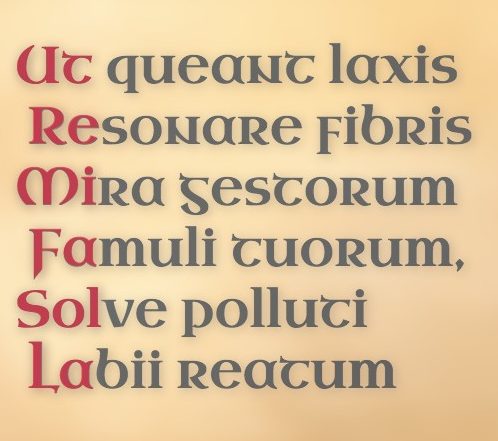Do-Re-Mi is something almost every musician is familiar with, but few realize that it’s not just a way to teach children to sing a scale; it’s a powerful ear training tool that professionals use to aid in transcribing, songwriting, and more.
What’s Solfege?
Solfege is essentially a method of naming pitches that assigns a syllable to each note of the musical scale. For example, instead of representing C major as C-D-E-F-G-A-B-C, solfege would name it as do-re-mi-fa-so-la-ti-do.

As you can imagine, these syllables give whatever melody you’re trying to hum a more “song-like” quality than if you were simply singing the actual note names. This is a helpful memory device that gives solfege its power.
Best of all, solfege can be applied to any scale – major, minor, non-traditional, you name it!
The Origins of Solfege
Though its exact phrasing has changed over the years, solfege is actually over a thousand years old!
A long time ago, an Italian monk named Guido d’Arezzo realized that the first syllable of each phrase in the Latin hymn “Ut Queant Laxis” began on each successive step of the musical scale. He went on to develop a six-note ascending scale based on the first pitch of each phrase, for a scale that initially was sung as ut-re-mi-fa-sol-la.

The first syllable, “ut”, was eventually changed to “do”, and “ti” was added to round out the scale, giving the syllables we know today.
What information does solfege give you?
Solfege is such a powerful tool precisely because it can tell you a lot with little information.
Suppose you hear two notes, and can recognize them as “so” going up to “do”. Here’s what this tells you:
- The pitch movement is from scale degree 5 to 1 (dominant to tonic)
- This implies harmonic (chord) motion of V-I
- The interval is a perfect fourth
How do we know all this? By using the system of movable “do”. This system of solfege assigns “do” to the tonic. In the above example, if you know the music is in F major, then you know that the interval you’ve heard is C-F.
Two Solfege Systems: Movable “Do” and Fixed “Do”
The system described above, called movable “do”, has a major advantage: you don’t need to know what key you’re in in order to accurately write out the melody you’re hearing in solfege symbols, because you already know the relationships between the notes!
There are, in fact, two systems for learning solfege: movable “do” and fixed “do”. While in movable “do”, “do” is always assigned to the tonic of the scale, fixed “do” keeps C as “do”, regardless of key.
Therefore, the note assigned to “do” changes in the movable system, but not in the fixed system. This may make the fixed system appear more easy and straightforward, but in fact, learning solfege through the movable “do” system will serve you better in the long run…
Advantages of Movable “Do”
Off the bat, you don’t need to worry about difficult transposition with movable “do” solfege – “do” is already whatever the tonic of that scale is.
Movable “do” is a great tool for learning to developing relative pitch, or learning to recognize the differences in pitch. Fixed “do” is great for musicians aiming for perfect pitch, but movable “do” is more versatile and will get you further in ear training.
Understanding the relationships between notes allows you to hum, play, or write the melody of your choice in any key, opening up new avenues in your songwriting and giving you more creative freedom in your music.
Solfege in Minor Keys
Remember how we mentioned that solfege is versatile as can be?
If you’re trying to hum a melody in a minor key using just the classic solfege syllables, you may find that you hit a wall; some of the pitches you’re trying to sing simply don’t correspond to any of the solfege syllables!
Enter the solfege accidental: you can raise or lower the pitch of a note by changing the vowel at the end of the syllable. For example, if you want to sing an E♭, sing “me” (rhymes with “may”) instead of “mi” (rhymes with “mee”).
Going further, there are two solfege systems for minor keys; one uses these new syllables, while the other does not.
“Do”-based minor
Here, the tonic is still represented by “do”. The lowered 3rd, 6th, and 7th degrees are represented by the syllables “me”, “le”, and “te”, respectively, rather than with the usual “mi”, “la”, and “ti” found in major keys.
“La”-based minor
In this system, “la” is assigned to the first degree of the minor scale, and because the A minor scale has no accidentals, the syllables do not need to be changed to accurately represent the melody in solfege.
A Quick Recap
Solfege, or the method of assigning syllables to pitches, is a valuable tool for any musician. This system will help you do the following:
- Recognize patterns in music
- Improve your sight-singing skills
- Transcribe music
- Learn relative pitch
- Recall melodies at will
- Improve your composingSo where can you start?
Check out our full solfege series to begin your training. We’ll take you through the theoretical basics behind the system, and give you practical exercises to get you recognizing intervals, humming melodies by sight, and recalling melodies in no time!